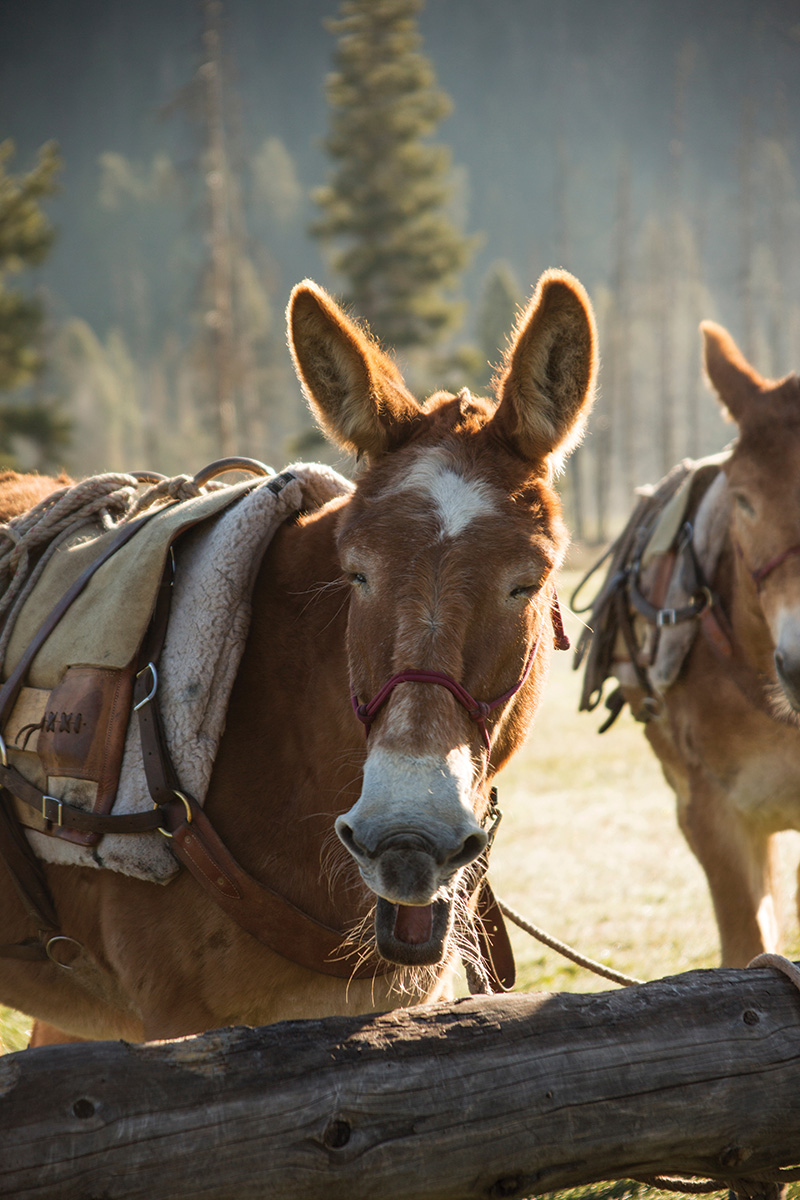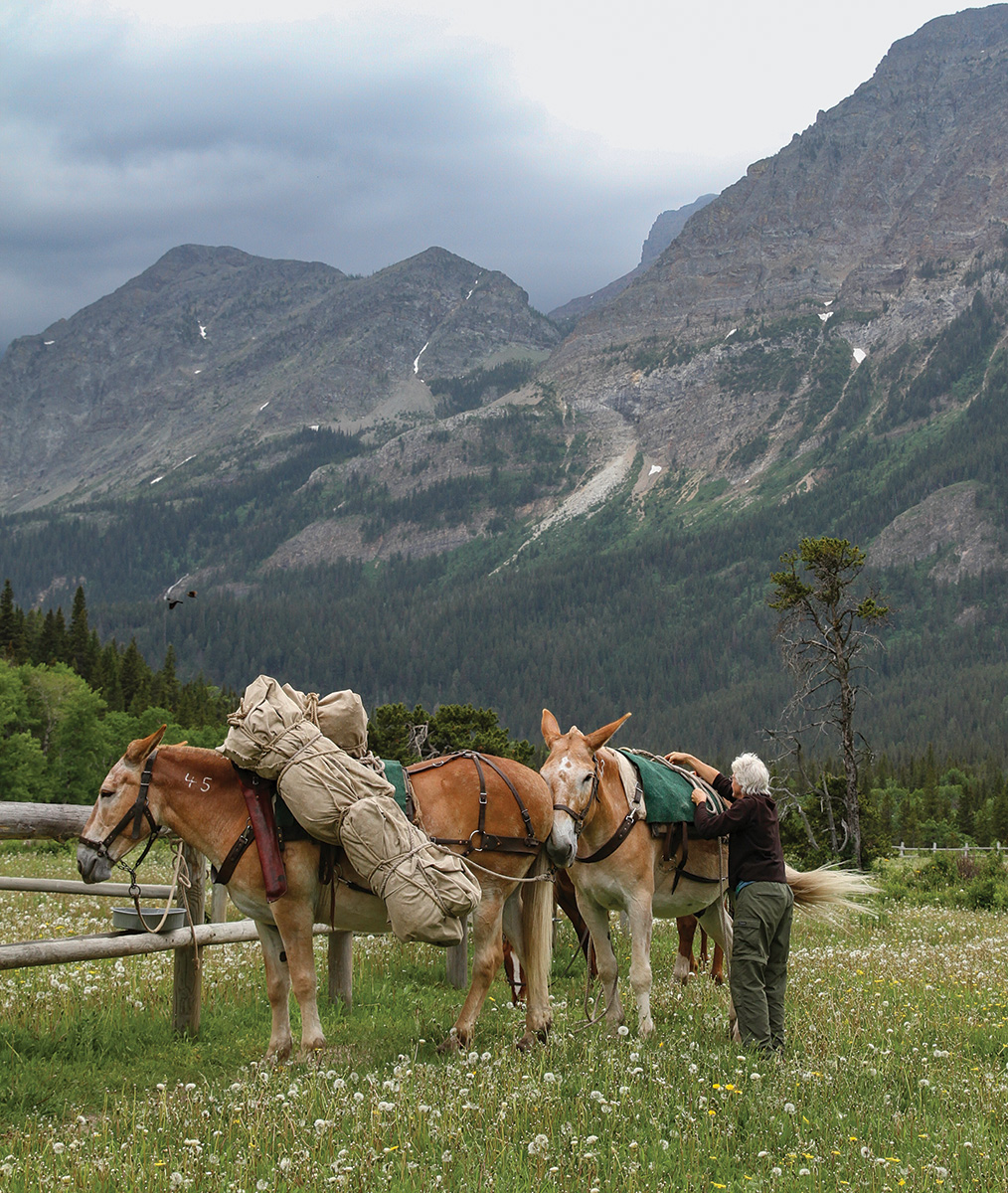The Working Mules of our Public Lands
Flopping ears bounce with every step down the trail as a string of six mules begin the trek from the Glacier National Park trailhead at the Canadian border to the Belly River Ranger Station two hours southwest.
The mules each carry two packs loaded with carpentry supplies that will aid the restoration and upkeep of the historic ranger station during the park’s summer months when park crews work to repair or create trails, cabins, and complete other projects before the winter returns to the northern Montana park.


Trail Crew
Leading the string of mules is Jill Michalak, who began working at Glacier in 2017. A member of the trails crew, Michalak’s job is to take care of and work with the mules and pack supplies as needed into and out of the park.
“The mules allow us to preserve and access the wilderness,” says Michalak. “Many of these areas not only don’t allow motorized vehicles, but don’t allow chainsaws. The mules have lots of different jobs. They work for the trail crew.”


Further south, contract packer Chris Eyer leads his own team of mules into the Bob Marshall Wilderness Complex (BMWC) out of his home base in Ovando, Mont. While Michalak works for the National Park Service, Eyer is employed by whichever licensed outfitter or arm of the United States Forest Service (USFS) needs him and his mules to move loads.
“I’ve packed boats for people going on rafting trips, mattresses, lumber, and things like that,” says Eyer. “As a contract packer, I also get hired by contractors who are not outfitters but work for the Forest Service, [for example] rebuilding a dam or bridge that is too big or specialized for the Forest Service.”
When hikers, mountain bikers, trail runners, and other equestrians use a trail system in America’s National Park System, public lands, or designated wilderness area, it’s more than likely that a mule carted in the equipment necessary to maintain that trail or build the outhouse they use that’s far back from the roadway.
Mules have carried the load for decades, aiding building, maintaining, exploring and surviving in the wilderness.
Packing with Purpose
Americans visited National Parks 312 million times in 2022, more than 15 million more visits than in 2021, according to the National Park Service. Most of those visitors never venture more than a mile into the park along a well-used and easily accessed trail. Yet there is a segment that opts to dig deeper into the National Park and wilderness areas considered public lands.
There are 63 National Parks, but more than 250 million acres of other public lands all managed by the U.S. Department of the Interior. Within that, the U.S. Forest Service facilitates work to ensure that public lands, like the Bob Marshall Wilderness Complex, is accessible to users.
That’s where packers like Eyer step in. Since 2006, he’s made a living packing cargo and other items for the USFS, the Bob Marshall Wilderness Foundation, and other contracted outfitters.
“The backcountry is for all users, from hikers and horses to skiers and runners,” he explains. “Mules bring in gear to keep the land open for all of these groups.”
Along with recreation, the wilderness areas provide opportunity to study many ecosystems and species without interacting with human population centers. Both Eyer and Michalak have packed in biologists completing research projects. Eyer has even brought in insects to the Big Prairie Ranger Station in the Flathead National Forest within BMWC.
“Packing in bugs is super complicated,” he says. “Never has more labor gone into a load that is as small as those bugs. The day before I leave to go in, there are people out in a field, on hands and knees collecting bugs to put into a canister. The bugs then go into a cooler to be kept from overheating. That is loaded onto a mule in the center of a load where they won’t be baked in the sun. As soon as I get to where I’m going, I unload mules and turn them out, then immediately head out with the USFS crew to release the weevils to a certain area where they go to attack an invasive weed species.”
For Michalak, who has worked as a packer in Alaska and at Olympic National Park, the most interesting project she packed equipment for was one conducted there by NASA.
“They were doing a project where they were ground truthing for a Doppler radar system,” she recalls. “We packed 15 miles into Enchanted Valley, packing lasers and solar panels. If you look at Olympic Peninsula, there is no other way to get into there except for mules, because there are no motorized options.” The project was projecting weather for a massive population center 200 miles away, in Seattle.
“In this day in age, mules were the way we got $30,000 laser equipment into the research area,” she adds.
Knowing which of the mules in a string is going to be more careful with a load and not apt to bump trees is important when carting expensive equipment. But most often, the loads carried are more common items, such as lumber, gravel, tools and food supplies.
Pack It On
Boxes wrapped in canvas are a typical scene if you’re hiking and encounter a mule string on the trail. Those boxes usually include food, tents and other items to make camp, or supplies to help restore a cabin. Restoration projects and construction are some of the most frequent loads for mules to make, especially into National Parks.
“The Park Service maintains a standard that anything older than 50 years is considered historic and must be maintained to those standards,” says Michalak. “When we packed into the Belly River Ranger Station, they were updating that cabin. [Carpenters] sourced the lumber for the flooring from the surrounding forest, but the lumber for the porch, we packed in. People wonder why we don’t use a helicopter, and there are a few reasons. First, they didn’t historically bring those items in by helicopter. Second, a lot of the National Parks have regulations as to how much aircraft traffic can go over the park.”
From Beams to Outhouses
The same goes for building or repairing a bridge or constructing a new dam, both of which are projects Eyer has packed materials for into the BMWC.
“Anything that is associated with the wilderness that requires heavy equipment or more than people can carry relies on mules,” he says. “The most challenging project was a bridge project where I packed tandem loads of steel columns that attached to two mules at the same time. It was a seven-week project.” Each pair packed two 186-pound steel beams.
From dams to outhouses, all the projects constructed in the backcountry rely on mule power to bring the items in or take them out.
“It’s common for bears to tear apart outhouses, and the park doesn’t leave those pieces out there,” says Michalak. “We pack those items—anything that won’t naturally decompose—out of the backcountry. Things like outhouses don’t just appear. While it would take a trail crew half a summer to haul those materials in, it takes a mule string one trip.”
Mules on a Mission
It can seem like a peaceful job, with the quiet of the wilderness all around, the echo of hooves ringing on the trails and the wide-open spaces. But there are many dangers associated with working in the backcountry, and they’re not only bear-related. Annually, fires ravage the land within national parks and designated public lands.
“There is an entire segment of packing that is focused on fire work,” says Eyer. “There are fire lookouts, fire crews, and a lot of work to keep the wilderness from burning, even though much of the wilderness has a ‘let it burn’ policy. Supplies have to be given to the people living in the lookouts for the fire season—food, water and all supplies.”
The parks also have to bring search and rescue crews to an injured person, but rarely airlift them out to decrease the mechanized noise. However, Michalak recalls one incident where her mules were used as Medivac, and not only to pack in supplies to those rescuing Backcountry Rangers.
“Once, at Olympic National Park, a woman broke her ankle about 11 miles down the trail,” she says. “There was a huge team of people looking for her, and the weather was really, really bad. I went in with a string of mules and packed the search and rescue team and EMT team’s food and tents in so they could focus on patient care. That was the only [person] I’ve ever packed out on a mule. She was a rare case because she grew up cowboying and had experience riding. Otherwise, the search and rescue team was going to carry her those 11 miles on a [stretcher].”
A Thank You to Backcountry Mules
Whether carting in tools and food to ensure that the park rangers get through a summer season or hauling in new lumber to build a bridge for access to the wilderness, mules are the ultimate cargo crew in the backcountry.
Without four legs to help build and maintain the infrastructure, America’s public lands wouldn’t be so easily accessed.
This article about the working mules of our public lands appeared in the April 2024 issue of Horse Illustrated magazine. Click here to subscribe!
Recent Posts
Sabrina Lewis and Her Crowning Achievements
Speaking on a stage surrounded by the glitz and glamour of the Miss America Pageant, Sabrina Lewis stands out with…
Equine Insurance Policies
Insurance. It’s a fact of life for most adults. We insure our vehicles, homes, businesses—even our smartphones. We buy life…
2025 Defender Kentucky Three-Day Event
Stay up to date on the action from the 2025 Defender Kentucky Three-Day Event. Find information about the event, including…
Cosequin® Lexington 4*-S at Defender Kentucky Three-Day Event presented by MARS Equestrian™ to Serve as US Equestrian Open Eventing Series Qualifier
Lexington, Ky. — This year’s Cosequin® Lexington 4*-S will serve as a US Equestrian Open Eventing Series Qualifier when the…
Ten Magical Days in Ocala: From Live Oak International to Longines League of Nations & More Horsey Adventures
Much like the cream center of an Oreo cookie, there is a sweet spot in the middle of Ocala winter…
ASPCA Right Horse Adoptable Horse of the Week: Rolo
Welcome to Horse Illustrated’s weekly installment of the Right Horse Adoptable Horse of the Week, offered in partnership with the…